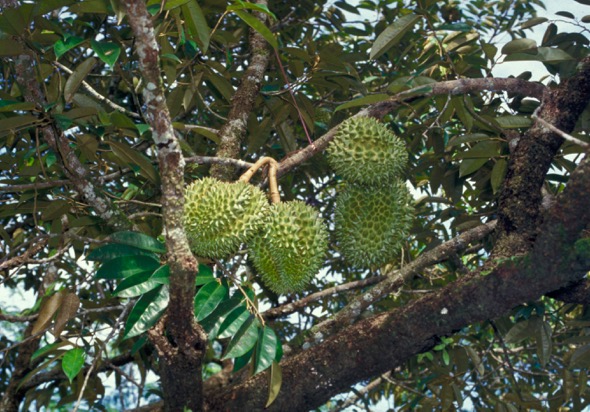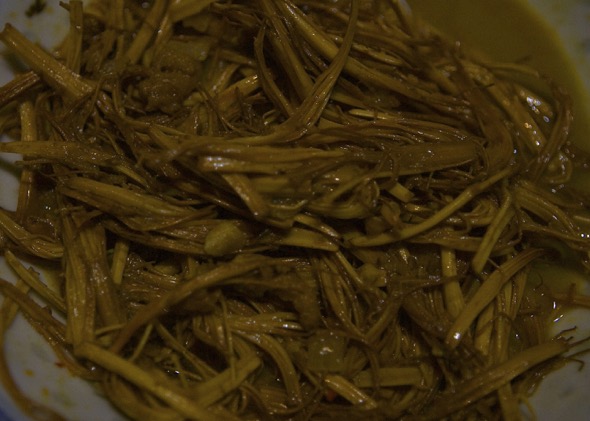The durian tree (Durio zibethinus) is wildlife friendly.

An old Durian tree (Durio zibethinus) attracts hornbills that use the rotting cavities along the trunks to nest in. The Gold-whiskered Barbet (Megalaima chrysopogon laeta) will chisel a nesting cavity in the semi-rotting branch.
During the flowering season the tree is visited by Common Fruit Bats (Cynopterus brachyotis) that seek out the flower nectar and in the process help in pollination. Spiderhunters have also been seen taking nectar or even stealing nectar from the flowers.
The ripening fruits attract plantain squirrels (Callosciurus notatus) that gnaw through the spiky fruit shell to get at the fleshy seeds. This opening allows sunbird, flowerpecker; laughingthrush, oriole, leafbird, and woodpecker to get access to the seeds inside.
When the ripe fruits drop to the ground, they split open to expose the fleshy seeds inside. This allows Long-tailed Macaque (Macaca fascicularis), wild pigs and even elephants access to the succulent seeds.

Of all the animals that are attracted to the durian tree, we must not forget Homo sapiens who relish the fruits. We consider them the king of fruits. However many Caucasians are overpowered by the powerful aroma and refer eating durians to eating custard in a toilet – an Asian squatting open air toilet, no doubt.
The yellow flesh is eaten straight from the fruits or can be scraped off the seeds and made into a variety of durian desserts, the recipes can be accessed HERE.
The large seeds are also edible after boiling, a little starchy but edible all the same.

Besides the fruits, the flowers are also eaten. These are collected during the flowering season when the ground below is littered with the loose flower parts – rings of sepals, petals and stamens. The petals and stamens are the edible parts, but the yellow anthers need to be removed as they may taste bitter. Stir fry with blachan (prawn paste), garlic, shallots and a dash of fish sauce and you have a delicious side dish. Alternatively, add curry powder instead of fish sauce.

YC Wee
Singapore
1st November 2016









11 Responses
Very interesting to see how much this tree contributes to its environment. Thanks for the post.
A very good summary of the durian fruits & the durian trees.
We greedily eat their food & they enter our homes to nest & eat ours!
Tit for tat lah! Ha! ha!
You got a point there Kimosabe… and you are most welcome Howard.
Unlike Rambuttan and Mangostein which are in high demand and have become very popular among farmers in Kerala State in India, the demand for Durian is less probably because of its limited availability. The only major source for Durian is from the horticulture farms maintained by the Horticulture Department of Tamil Nadu State in Kallar and Burliar in Nilgiris District. The demand for the fruit and also its saplings is now incresing in view of its reported property of treating ‘infertility’!
Good to know that the fruit can be used to treat infertility! Do you know that the Indonesians and Malays believe the fruits have aphrodisiac properties? … as the saying goes “Durian jatoh, sarong naik” … meaning that when the durian falls (i.e. durian season), the sarong goes up.
Let me finish your uncompleted Pantun, YC:
“Musim durian
Buah jatoh;
Sarong niak
Tutup pintu;
Padam lampu;
Buka kian
Baru m..n”
Now it’s complete!
Thanks Kim. How about the tune?
Try with “Burung Kakak Tua”
Thanks.
I recently learned that Indonesia has some “red durian”. Have you heard about this? The flesh is actually red in colour (as opposed to the usual yellow). Is this a different species of durian?
Yes, have heard about it. Not sure whether same or different species. But the black durian is a different species… https://besgroup.org/2016/04/16/great-hornbill-feeding-on-black-durian-fruit/